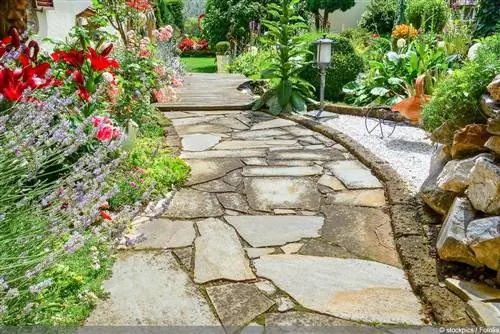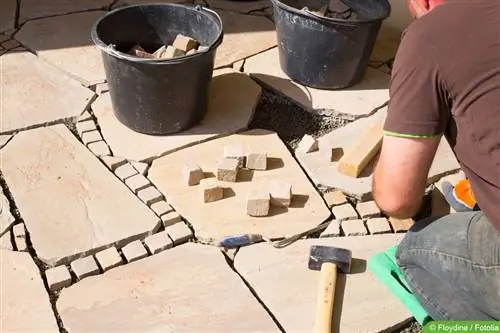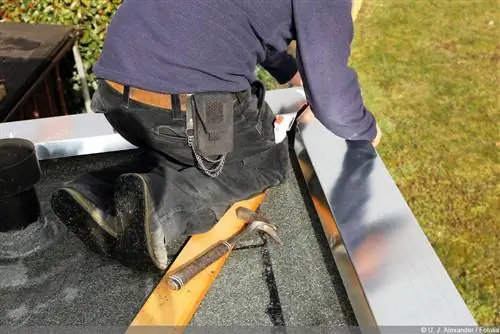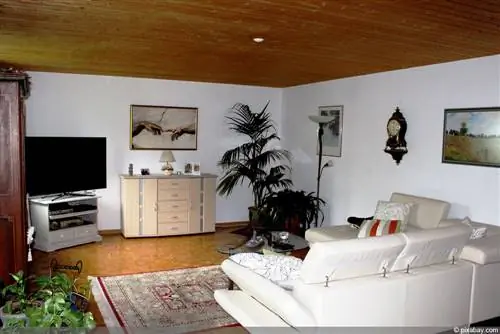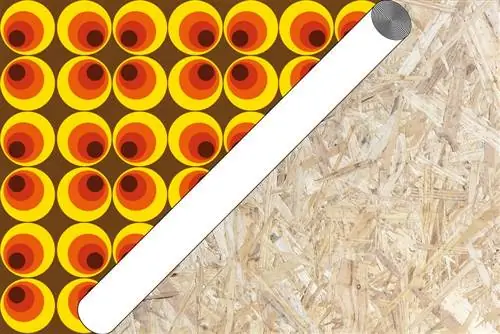- Author admin [email protected].
- Public 2023-12-17 03:39.
- Last modified 2025-06-01 06:48.
What could be more stylish than a terrace or garage entrance made of natural stone slabs? The irregularly shaped slabs made of porphyry, granite or limestone in particular create a wonderfully natural ambience. However, when laying these polygonal panels, there are a few things to keep in mind. With our tips, even inexperienced do-it-yourselfers can easily lay the irregularly shaped panels with a little skill.
The right material
Depending on where you want to lay the polygonal panels, you need to choose the right material. Outdoors, the stone must be frost-resistant.
- Sandstone: relatively abrasion-resistant and frost-resistant, but is attacked by road s alt
- Quartzite: frost and abrasion resistant
- Granite: resistant to frost and road s alt, abrasion-resistant
- Limestone: less abrasion-resistant, sensitive to acids and s alts (limitedly suitable for outdoor use)
- Porphyry: very resistant, ideal for garage entrances and terraces
- Marble: not frost-resistant, therefore not suitable for outdoor laying
Substructure
Before you start laying the polygonal panels, a suitable substructure must be created. For larger areas such as terraces or garage entrances, polygonal panels should not be laid in gravel or gravel. A natural stone surface in the garden needs a weather-resistant foundation. If the area is to be used by a car, it must be particularly stable. There are various options for the substructure. Which variant you should choose depends primarily on the surface and the load to which you expose the area:
- Layer of gravel and sand plus concrete slab (most stable solution)
- Mineral mixture or KFT (combined frost-proof base layer), grain size 0 - 32 mm
- Gritted or gravel bed (only for smaller areas and pure sidewalks)
For the foundation, the soil is excavated to the appropriate depth and then filled with a layer of gravel and sand or mineral concrete. The gravel bed must be compacted with a vibrating plate so that no voids are created. An additional 15 centimeter thick concrete slab is then poured onto the gravel bed. After the concrete has dried thoroughly, you can start laying the panels. Alternatively, mineral concrete (KFT) can also be filled in as a substructure. After compacting, the layer should be at least 20 centimeters high. An additional layer of concrete is not necessary in this case.
Tips for the substructure

- To be on the safe side, the substructure and thus the excavation should reach down to the depth of frost. You can obtain information about the frost depth in your area from the local building authority.
- When laying polygonal panels, it is important that the substructure is laid away from buildings with a gradient of around 1.5 to 2% so that the water is not directed towards the house or garage.
- So that the substructure is stable, earth should always be removed. Excavation is also necessary if the path or terrace is set higher than ground level.
- In practice, a layer of KFT has proven to work well for terraces and sidewalks. The mineral mixture is easy to compact, very frost-resistant and has good load-bearing capacity. Even a shift of 20 is suitable for occasional driving. For heavier loads, a 30 centimeter thick base layer is recommended.
- You can create the most stable and durable surface with a foundation made of a gravel bed plus a concrete slab.
- It is advisable to paint a concrete slab with a primer before laying it. Once the primer has dried, a layer of liquid terrace waterproofing follows. Where the terrace or path borders the house or a wall, a strip-shaped seal makes sense.
Laying in a bed of grit or gravel
A lot of experience is required when laying polygonal panels. The work should therefore preferably be carried out by a specialist or experienced do-it-yourselfer. In general, polygonal tiles can be laid in the gravel bed, but in most cases this is not recommended. Because there is a risk that the plates will shift and tilt. Nevertheless, this method has proven itself useful for laying garden paths.
- Dig up the soil to frost depth and fill it with fine gravel or chippings.
- If necessary, fill the gaps with sand to achieve better load-bearing capacity.
- Slightly compact the gravel bed for larger areas with a vibrating machine.
- Put the plates on and tap them into place with a rubber mallet. Make sure the overall surface is flat.
- Group joints with grit or coarse sand.
Tip:
It is important that only large and heavy slabs that are at least three centimeters thick are laid as stepping stones. With polygonal slabs in the gravel bed, there is a great risk that weeds will settle in the joints. Over time, the roots can lift the panels in some places, creating an increased risk of tripping.
Laying on mineral concrete or concrete slab

In all other cases, the polygonal panels must be laid with a frost-resistant substructure.
Tool
- Inch rule
- Setting batten
- Spirit level
- rubber hammer
- Joint iron
- Mortar bucket (or bucket)
- Mason's Trowel
- comb spatula
- Pouring cup with spout
- Sponge
- Guideline
- Cartridge syringe for silicone cartridges
Personal protective equipment
- Work gloves
- Knee pads
- Safety glasses
Machines
- vibration plate
- Agitator (drills with agitator attachment are too weak for the tough mortar)
- Angle grinder or diamond saw
Material
- Polygonal panels in appropriate quantities
- Mineral concrete or mineral mixture, grain size 0-32 mm (as a combined frost-proof base layer)
- alternative: gravel, sand and concrete
- Bedding mortar
- Trass cement for grouting
- Cement film remover
- possibly boundary stones
- Natural stone silicone
Laying polygonal panels
There are various steps required to lay the polygonal panels. We will show you the steps in detail:
Step 1: Prepare plates
It has proven useful to first spread the irregular natural stone slabs dry on the subsurface before final laying in the mortar bed. This means you can set a successful pattern without any time pressure and, in an emergency, completely reschedule if something doesn't fit. Before applying the mortar, the surface should be clean and slightly damp. Loose stones or dust prevent a good bond with the mortar. Therefore, sweep the concrete slab thoroughly in advance.
- First sort the plates by size and color.
- If you want the surface to have a straight finish, look for larger rectangular polygonal plates. These are perfect for the corners. All panels with long, straight edges are suitable for side borders. If such slabs are not available in sufficient numbers, you may have to cut individual stones into the correct shape using an angle grinder or a diamond saw.
- If necessary, stick a piece of masking tape on each of the stones and number them consecutively.
- Once all the larger panels are in place, choose smaller pieces to fill wider spaces. If necessary, remaining plates must be broken for this purpose.
- Clean the plates with a sponge and clean water. Dirt and dust on the back of the natural stones hinder the adhesion of the mortar.
- For polygonal panels made of bas alt, the back should also be roughened with a claw board and cleaned under running water. A contact slurry as a bonding bridge makes installation easier.
Step 2: Lay curbs
If the terrace or path is to have a straight edge, the curbs are laid first. These are placed in a foundation made of lean concrete and tapped into the appropriate depth with a rubber mallet. To do this, stretch a guide line over the entire length of the edge to ensure that the stones are in a straight line and at the same height.
- If you have planned an additional edging made of other stones, both this and the first row of polygonal slabs with straight edges are laid in the lean concrete bed so that they do not move.
- Start by laying the curbs on the house wall or another boundary so that there are no gaps that are too wide later.
Step 3: Insert natural stone slabs
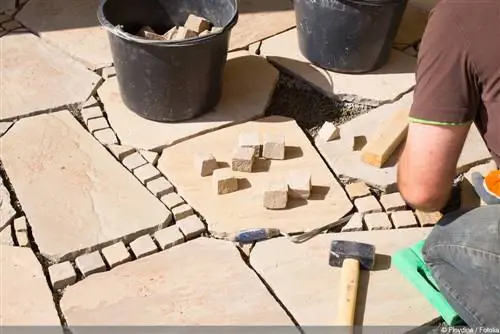
Now lay the remaining stones away from the end. To do this, apply a layer of bedding mortar about 5 centimeters thick to the mineral concrete or concrete slab and straighten the mortar with a wooden board or a scraper. Carefully press the pre-sorted stones into the earth-moist mortar bed. Be sure to pay attention to the height and the width of the joints. The typical joint width for polygonal panels is around 3 to 5 centimeters. The stones are then tapped into place with a rubber mallet. You should always use a spirit level to ensure that the surface is flat and that there is a necessary slope away from the house. If there are larger joints, these are immediately filled with smaller fragments.
Tips
- If the substructure consists of a concrete slab, this should be moistened before applying the mortar so that the mortar adheres better. The installation is carried out moist on moist (not wet). This means that both the substrate and the polygonal panels should be slightly damp when laying.
- Only as much mortar is applied as is needed to lay around two to three panels.
- Only mix small amounts of mortar fresh. Since it is applied very thickly (thick bed process), it hardens very quickly. Dried residues in the cement tub should no longer be used. For beginners, we recommend mixing half a bag at a time.
- If the panels are of different thicknesses, always start with the thinner panels to ensure an even surface.
- When tapping in larger slabs with a rubber mallet, it is best to use a protective board so that there are no cracks or gaps in the natural stone.
- When you press and tap the natural stone slabs, the gaps fill more or less with laying mortar, depending on the thickness of the natural stone and the pressure you apply. This should be removed promptly with a joint iron.
- Protect the newly laid surface from rain if necessary. A large film that is weighted down with stones or wooden slats is suitable for this to prevent it from flying away.
- Do not step on the freshly inserted polygonal panels until the mortar has hardened well. Otherwise the plates will shift and you will get an irregular surface.
Grouting polygonal panels
To grout the natural stone slabs, you need trass cement, which is either added to the joints with a trowel or poured liquid into the gaps. Grouting may only be carried out when the laying mortar has completely hardened. To be on the safe side, wait a day after laying before you start grouting.
- Be careful not to dirty the panels unnecessarily when pouring joints, as cleaning them later can be problematic or even impossible. If some of the grout goes wrong, it should be wiped off immediately with a damp cloth or sponge.
- The consistency of the mortar for paving joints must be liquid so that it can be easily poured into the joints. In order for it to harden well, it must not be too watery.
- Before the actual grouting, the gaps and the stones must be moistened with water. A tassel (paper brush) or a sponge is suitable for this.
- The liquid trass cement can be poured in precisely using a cup with a handle and spout.
- When grouting, proceed step by step. After pouring the grout to a level slightly below the polygonal panels, wash and smooth it with a damp sponge. Be sure to wash off any residue from the plates with a clean sponge.
- The side of the house or a wall connection is not filled with joint compound. At the very end, after the joint compound has hardened, an expansion joint is created between the remaining stones using natural stone silicone.
Theses

After the grout has hardened, the entire installation surface is thoroughly washed with water. In order to get rid of the gray haze, cement film remover is necessary. Follow the instructions on the packaging and wear appropriate protective clothing if necessary.
Tip:
The cement film remover must match the natural stone being laid, otherwise its surface can be attacked. Limestone and joints, for example, do not tolerate acidic agents.
Sealing
In order to permanently protect the new natural stone terrace against weather influences and moss growth, a sealant can be applied after cleaning and drying.

